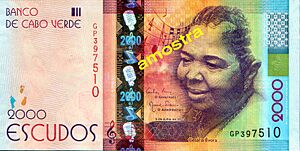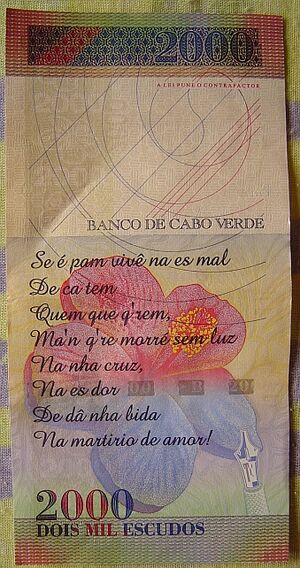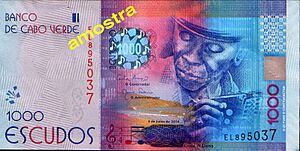Cape Verdean escudo facts for kids
Quick facts for kids Cape Verdean escudo |
|||
|---|---|---|---|
|
|||
| ISO 4217 Code | CVE | ||
| User(s) | |||
| Inflation | 0.6% | ||
| Source | September 2015 | ||
| Pegged with | euro (1 EUR = 110.265 CVE) | ||
| Subunit | |||
| 1⁄100 | centavo (discontinued) | ||
| Symbol | |||
| Coins | |||
| Freq. used | 5, 10, 20, 50, 100 escudos | ||
| Rarely used | 1, 200, 250 escudos | ||
| Banknotes | 200, 500, 1000, 2000, 5000 escudos | ||
The escudo (its symbol is ![]() ) is the money used in Cape Verde. This is an island country located off the coast of West Africa. The official code for the Cape Verdean escudo is CVE.
) is the money used in Cape Verde. This is an island country located off the coast of West Africa. The official code for the Cape Verdean escudo is CVE.
One escudo used to be divided into 100 smaller parts called centavos. However, centavo coins are no longer used today. When writing amounts, people in Cape Verde often use the escudo symbol (cifrão) as a decimal point. For example, 20 escudos might be written as 20![]() 00.
00.
Contents
History of the Escudo
The escudo became the official money of Cape Verde in 1914. It took the place of the old money, which was called the Cape Verdean real. When this change happened, 1000 réis (the plural of real) were equal to 1 escudo.
Before 1930, Cape Verde used coins from Portugal. However, special banknotes (paper money) were printed for Cape Verde starting in 1865. These were made by the Banco Nacional Ultramarino.
Escudo's Value Over Time
Until Cape Verde became independent in 1975, its escudo had the same value as the Portuguese escudo. After independence, the value of the Cape Verdean escudo went down. It lost about 30% of its value in 1977–78. It then lost another 40% in 1982–84. After these changes, its value stayed quite steady compared to the Portuguese escudo.
In 1998, Cape Verde made an agreement with Portugal. This agreement set a fixed value: 1 Portuguese escudo was equal to 0.55 Cape Verdean escudos. When Portugal switched to the euro, the Cape Verdean escudo also became linked to the euro. Now, 1 euro is always equal to 110.265 Cape Verdean escudos. Portugal's government helps support this fixed value.
Coins of Cape Verde
Coins have changed a lot in Cape Verde over the years.
Coins Before Independence
In 1930, when Cape Verde was still under Portuguese rule, new coins were made. These included values of 5, 10, 20, and 50 centavos, plus 1 escudo. The smaller centavo coins were made of bronze. The 50 centavos and 1 escudo coins were made of nickel-bronze.
Later, in 1953, more coins were added. These included a bronze 1 escudo coin, a nickel-bronze 2+1⁄2 escudos coin, and a silver 10 escudos coin. In 1968, bronze 50 centavos and nickel-bronze 5 escudos coins were also introduced.
Coins After Independence
After Cape Verde became independent in 1975, new coins were released in 1977. These coins came in values of 20 and 50 centavos, 1, 2+1⁄2, 10, 20, and 50 escudos. The centavo coins were made of aluminum. The 1 and 2+1⁄2 escudos coins were nickel-bronze. The higher value coins were made of cupro-nickel.
Over time, prices went up (this is called inflation). Because of this, the centavo coins slowly stopped being used. Eventually, the 1 escudo coin became the smallest coin still in use.
Modern Coins
The coins used today were first made in 1994. The smallest is a 1 escudo coin, which is made of brass-plated steel. However, this coin is not used very often. Shops usually round prices to the nearest five escudos. This 1 escudo coin has a sea turtle design.
Other coins come in three different design styles. These include the 5 escudos (copper-plated steel), and the 10, 20, and 50 escudos (nickel-plated steel). There is also a 100 escudos coin, which has two different metals and is shaped like a decagon (a 10-sided shape).
The three design series for these coins feature:
- Native animals, like birds and reptiles.
- Historical ships, with their names.
- Native plants and ferns.
Special 200 escudo coins have also been made. Some were released in 1995 to celebrate the 50th anniversary of the FAO (Food and Agriculture Organization) and 20 years of Cape Verde's independence. Another round 200 escudo coin was made in 2005 to mark 30 years of independence. These 200 escudo coins are not as common as other coins, but they are still used and accepted.
Banknotes of Cape Verde
Banknotes are the paper money used in Cape Verde.
Early Banknotes
In 1914, the Banco Nacional Ultramarino started printing notes. These were for 4, 5, 10, 20, and 50 centavos. In 1921, they issued notes for 1, 5, 10, 20, 50, and 100 escudos.
A new series of notes came out in 1945. This series did not include any notes smaller than 5 escudos, because coins had replaced them. This series also introduced 500 escudo notes. Later, in 1953, 10 escudo notes were replaced by coins. The 5 escudo note was also taken out of use.
Banknotes After Independence
After Cape Verde became independent on July 5, 1975, new banknotes were issued on July 1, 1977. These were for 100, 500, and 1000 escudos.
The next set of banknotes was introduced in 1989. This series included 100, 200, 500, 1000, and 2500 escudos.
Modern Banknotes
A third series of banknotes was released in 1992. These were for 200, 500, and 1000 escudos. In 1999, 2000 and 5000 escudo notes were added. The 200 escudo note was updated in 2005. The 500 and 1000 escudo notes were redesigned in 2007.
On December 22, 2014, the Banco de Cabo Verde (Bank of Cape Verde) introduced a brand new series of banknotes. These notes celebrate important Cape Verdean people from literature, music, and politics. The 200, 1000, and 2000 escudo notes were issued in 2014. The 200 escudo note is now made from a special plastic material called polymer. The 500 and 5000 escudo banknotes were issued in 2015.

See also
- Currencies related to the euro
- Economy of Cape Verde






